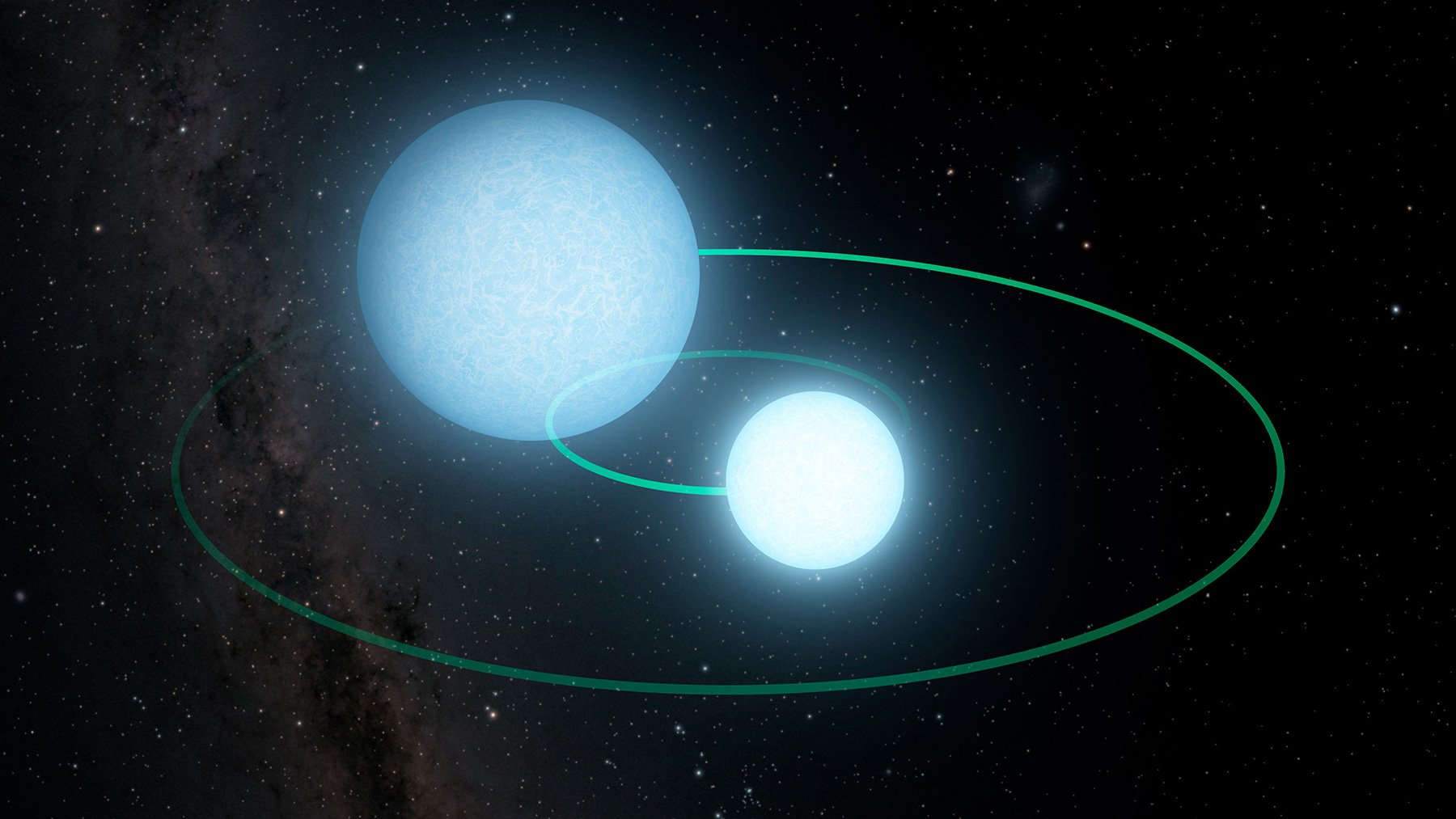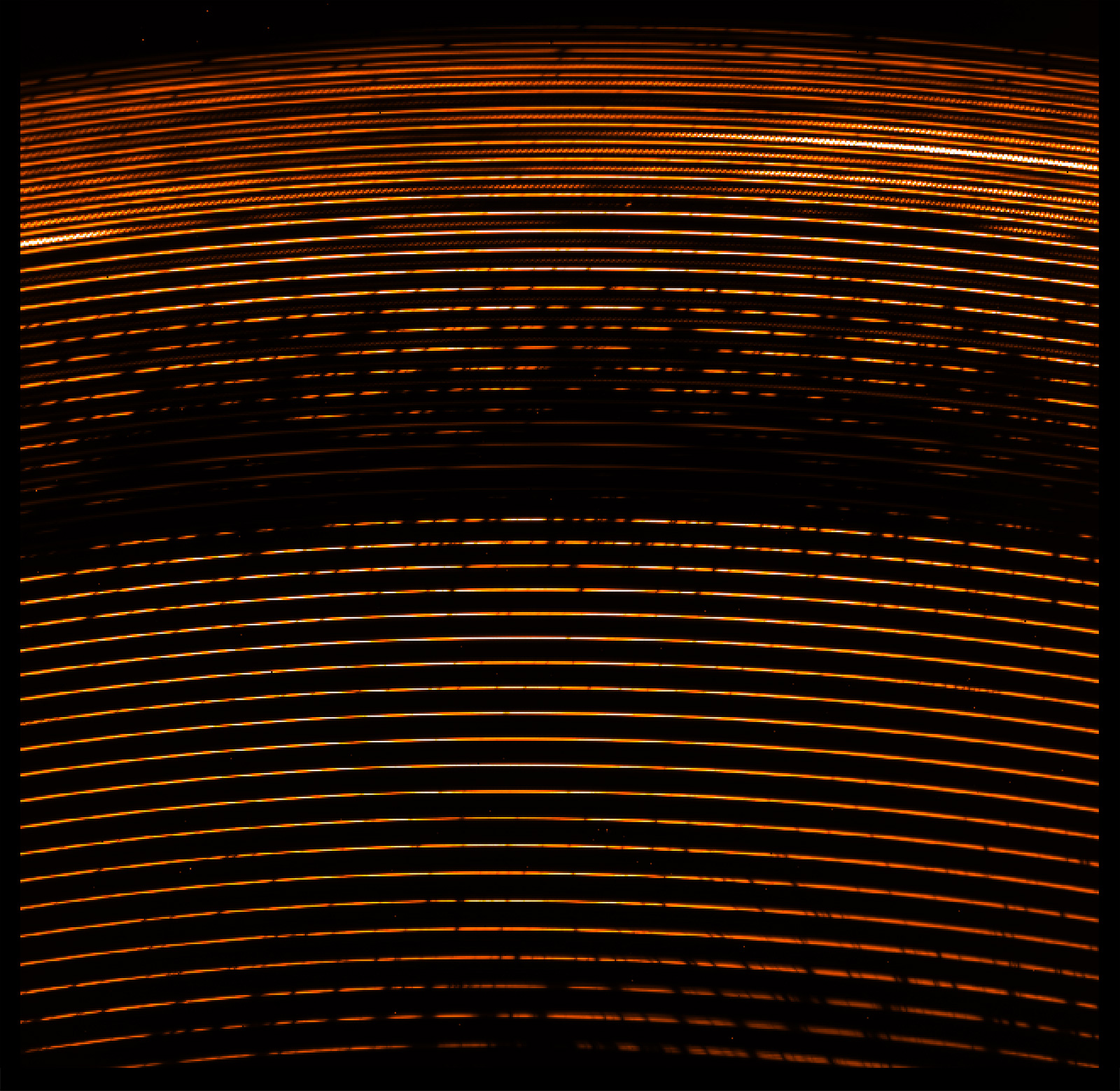In this issue

No. 4
Summer 2019
Palomar Science Highlight: A Seven Minute Binary Star and Its Orbital Decay Due to Gravitational Wave Emission
By Kevin Burdge (Caltech)

Artist's impression of a pair of orbiting white dwarfs, called ZTF J1530+5027. This eclipsing binary pair orbit each other roughly every seven minutes: when the larger, cooler star passes in front of (or eclipses) the smaller, hotter star, the light of the smaller star is blocked. To astronomers observing the system, the pair appears to vanish for around 30 seconds during the eclipsing phase of their orbit. (Caltech/IPAC/R. Hurt)
The Zwicky Transient Facility at Palomar Observatory recently identified the shortest orbital period eclipsing binary system currently known—ZTF J1539+5027. ZTF J1539+5027 consists of two white dwarfs, and its semi-major axis is so small that the entirety of the binary could be contained within the planet of Saturn. The system undergoes a total eclipse every ~6.91 minutes. This rare celestial finding is published in an article “General relativistic orbital decay in a seven-minute-orbital-period eclipsing binary system” in Nature on July 24, 2019 (Burdge et al. 2019, Nature, 571, 528). Such a system is the first from a systematic search over the two-thirds of the sky by ZTF, and more are expected to come. This result has also been widely reported on news media last month.
The significance of this short period binary is that it is a strong LISA gravitational wave source, with a precisely measured orbital decay due to gravitational wave emission. The system was monitored carefully during many nights using the Palomar 200-inch Hale Telescope. By using the multi-channel high-speed photometer CHIMERA, we were able to precisely time the eclipses of this system to accuracy of milliseconds. The photometric monitoring showed that the eclipses were occurring sooner and sooner than expected compared to a system with a constant orbital period, indicating that this binary is undergoing rapid orbital decay due to general relativity. Moreover, by digging into forced photometry from archival Palomar Transient Factory (PTF) data, we are able to measure the eclipse times of this system as far back as 10 years ago, enabling highly precise measurement of the orbital decay.
This rare binary is one of the few known sources of gravitational waves that will be detected by the future European space mission LISA (Laser Interferometer Space Antenna) which operates at lower frequencies than LIGO and thus is sensitive compact binary systems with orbital periods of millihertz. Searches for ZTF J1539+5027 like objects will pave the way for future studies of gravitational wave emission and astrophysical understanding of compact binary mergers. The combination of ZTF on the Palomar 48-inch and CHIMERA on the Palomar 200-inch telescopes holds a very promising future for finding many more similarly exciting systems.
Palomar Observatory Announces CHIMERA as a Facility Instrument for the 2020A Semester
By Jennifer Milburn and Lin Yan (Caltech)
The CHIMERA instrument will transition to facility status (i.e., generally available to the entire P200 community) in the upcoming 2020A observing semester. CHIMERA is a high-speed, two-color photometer located at the prime focus of the Hale Telescope. It was developed by Gregg Hallinan at Caltech in collaboration with engineers at JPL and Caltech Optical Observatories. The instrument is optimized for monitoring variable sources on time scales from tens of milliseconds to hours. One great example of the CHIMERA usage is the recent photometric monitoring of the shortest period (6.91 minutes) white dwarf and white dwarf binary ZTF J1539+5027 (Burdge et al. 2019, Nature, 571, 528).
CHIMERA operations software has been updated to support facility status. A series of new features have been added to make it easier for novice observers to use the instrument. These changes include a simplified user interface for controlling both the red and blue channels separately. These new GUIs allow users to specify the most important exposure parameters and monitor observing progress. An additional upgrade is to implement GPS timestamps for each individual frame in an image FITS cube. This allows precise timing of variable sources on short time scales. Finally, the guide star selection is now automated for both individual exposures as well as for image cubes.
Observers who plan to use this instrument are encouraged to check the instrument webpage and contact Jennifer Milburn (jwm [at] astro.caltech.edu) for any questions.

The updated CHIMERA user interface. Two distinct GUI windows control exposure parameters for the red and blue channel separately. The additional diagnostic tools are now hidden behind the button labeled "Advanced." Users can still access other functionalities through the Advanced option. (J.Milburn/Caltech)
Palomar 200-inch Remote Observing Policy
By Richard Walters (Caltech)
As part of a review of the Caltech remote observing program for Keck and Palomar, we have updated and revised our remote observing policy. These changes will take effect on September 1, 2019. The full policy can be found online here as well as a hard copy located in each of the remote observing rooms. Currently, Palomar Observatory supports sites at:
- Cahill remote facilities
- Yale remote facility
- NAOC Beijing P200 remote facility
The Cahill remote observing site can support JPL/IPAC P200 users. Any questions for these respective three sites should be sent to rof [at] astro.caltech.edu (Caltech), Craig Henry (craig.henry [at] yale.edu, Yale) and Sophia Dai (ydai [at] nao.cas.cn) and Yue Chen (chenyue [at] nao.cas.cn) (China).
All current users should take note of the new policies listed below:
- At least one proficient observer (defined as a user with experience directly tied to the instrument in use) must be present during a remote observing sessions.
- Remote observing will only be supported from pre-approved designated sites.
- Designated sites should have one appointed representative to handle network support.
- All requests for remote observing should be submitted through the request portal and arrive 4 weeks before the initial run date.
- Failure to send in request for remote observing may result in the loss of privileges to the designated remote observing site.
- Remote observing is offered on a shared-risk basis and the observer team assumes all risk associated with observing time lost to connectivity issues.
- The Observatory shall only accept RO requests from authorized individuals: either the Administrative PI or the designated Lead Observer (LO) for an investigation. No other individuals will be deemed authorized to request RO on behalf of an investigation.
- The following instruments are now supported for remote observing:
- DBSP
- TripleSpec
- WaSP
- WIRC
- CHIMERA
Please review the full document online and if you have any questions please contact rof [at] astro.caltech.edu.
NAOC-Beijing P200 Remote Observing Facility
Lin Yan (Caltech) and Y.Sophia Dai (NAOC)
The National Astronomical Observatories of China (NAOC) is working closely with Palomar Observatory to establish a permanent P200 remote observing site located in Beijing. It is expected that connectivity and operations tests will be completed in the fall of 2019. This site will have a dedicated observing room at NAOC with technical support by NAOC staff. We encourage P200 observers from China to use this remote facility.
In addition, Palomar Observatory has recently released a revised policy on supporting remote observing requests. All remote observing requests should be submitted to the observatory via a web form at the request portal four weeks ahead of an observing run (see details in this issue). To reserve the NAOC-Beijing remote observing facility and request help, please contact Sophia Dai (ydai [at] nao.cas.cn) and Yue Chen (chenyue [at] nao.cas.cn).
PARVI on P200 Sees Its First Light
By Andy Boden and Lin Yan (Caltech)
PARVI (PAlomar Radial Velocity Instrument) has seen its first light on 14 June 2019. This will be a new instrument on the Hale Telescope for exoplanet radial velocity measurements.
PARVI is developed by a collaboration between Jet Propulsion Laboratory (JPL), American Museum of Natural History (AMNH), and Caltech scientists and engineers. It has the promise of making radial velocity measurements at a precision of 1 m/s for nearby bright stars. PARVI recently passed a major technical hurdle by having successful first-light observations Friday 14 June 2019. PARVI’s first-light milestone is a particularly significant accomplishment given that PARVI is a novel instrument in several different ways.

PARVI first-light spectrum of the bright star Arcturus from 14 June 2019. The PARVI spectral format is typical of echelle spectrometers, with wavelength dispersion along the image horizontal axis, and multiple spectrum orders (the curved semi-horizontal lines) separated (or cross-dispersed) along the image vertical axis. (The PARVI Development Team)
Large planets like Jupiter typically induce reflex motion on the order of 10s to 100s m/s, and a planet like Earth around a Sun-like star would induce smaller motions around 10s of cm/s. It is these smaller planets, particularly around nearby lower mass stars, that animates the PARVI instrument and makes it an excellent facility for followup study of planet detections from NASA’s TESS mission. PARVI’s first novelty is its physical separation from the Hale Telescope (even in a different floor of the dome!), with light conveyed from the telescope to the instrument by an optical fiber. This allows PARVI to operate in a carefully-controlled and stable physical and thermal environment—important for making precise measurements over an extended period of time. Further, the optical fiber used to transport the starlight is a “single-mode” fiber, which effectively means that the fiber preferentially delivers only a very stable and unaberated optical wavefront to the instrument. To make fiber injection practical, PARVI uses the Hale Telescope’s PALM-3000 adaptive optics system to mitigate atmospheric distortion. PARVI’s second novelty is that it works at the near-infrared, which is sensitive to planets around low-mass stars. Further, in addition to the input star’s spectrum, PARVI injects a parallel “laser-comb” wavelength reference, which helps mitigate measurement errors due to time-varying instrument misalignments and drifts resulting from vibrations and temperature changes.
We are excited to see this emerging Palomar instrument and the important science it will enable. With PARVI, Palomar is positioning itself to continue making relevant contributions to our study and understanding of exoplanets around nearby stars.
Questions? We've answered many common visiting, media, and academic questions in our public FAQ page.
Please share your feedback on this page at the
COO Feedback portal.
Palomar Observer 4
Last updated: 10 September 2019 LY/AFB/ACM